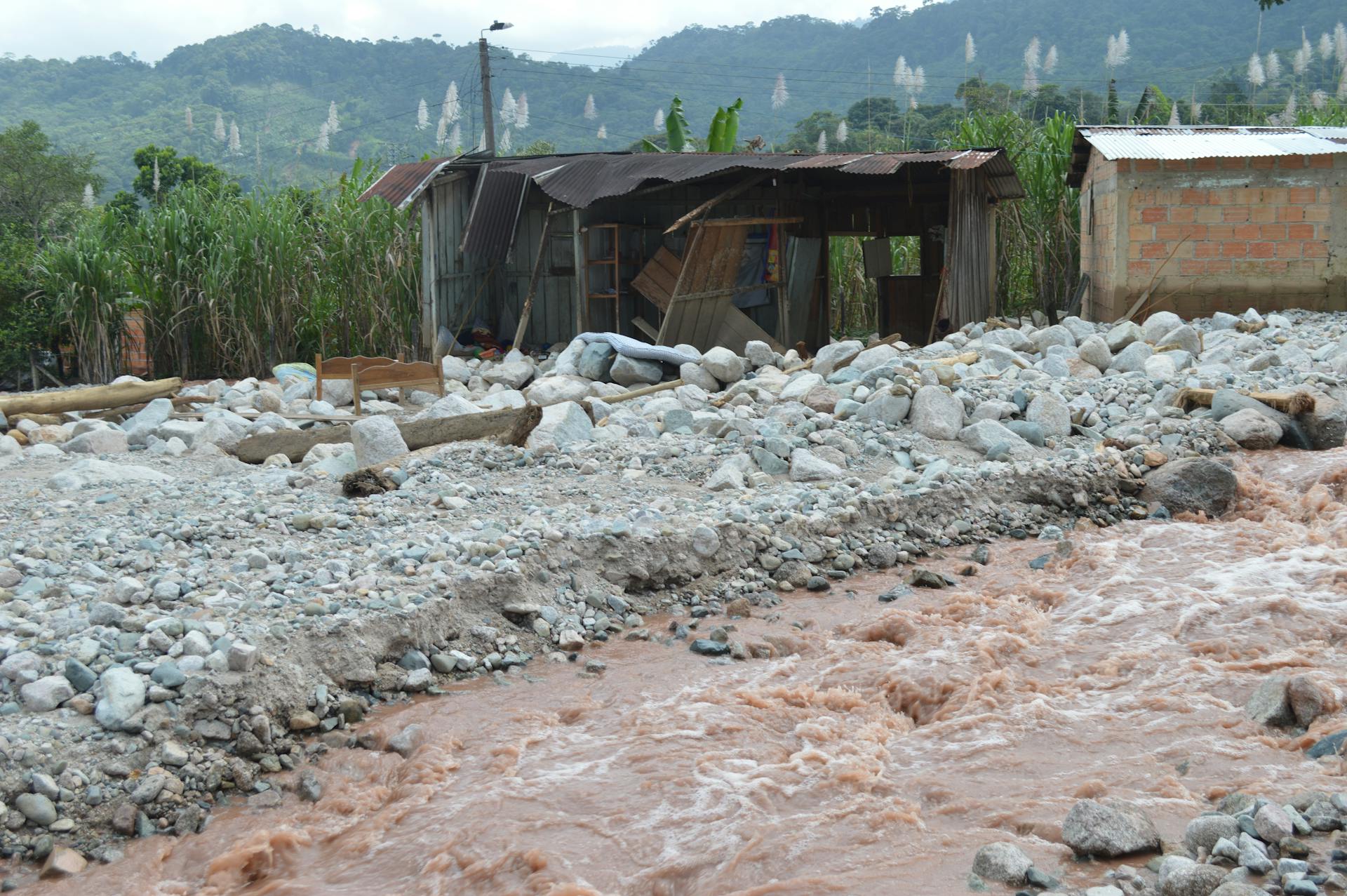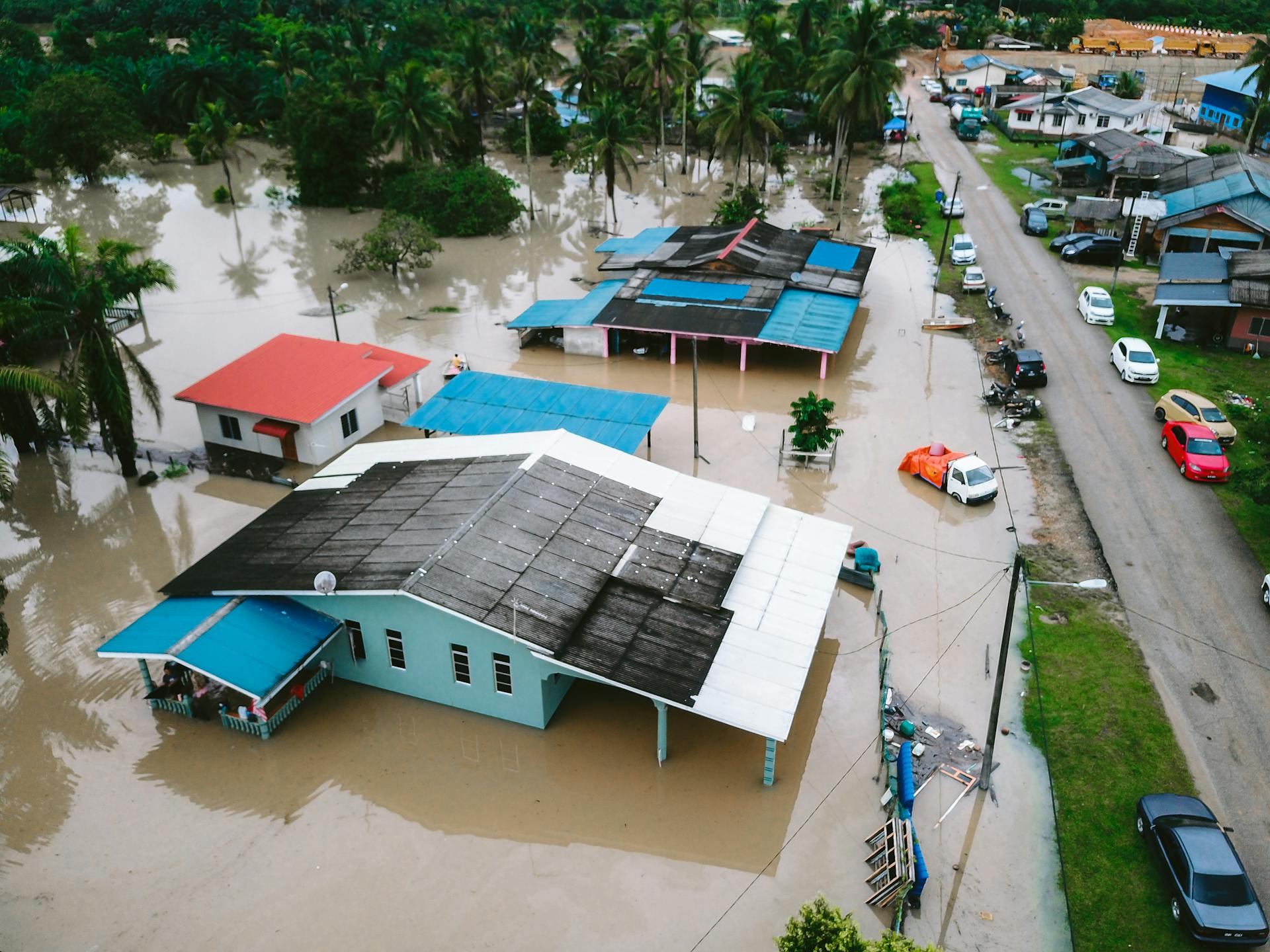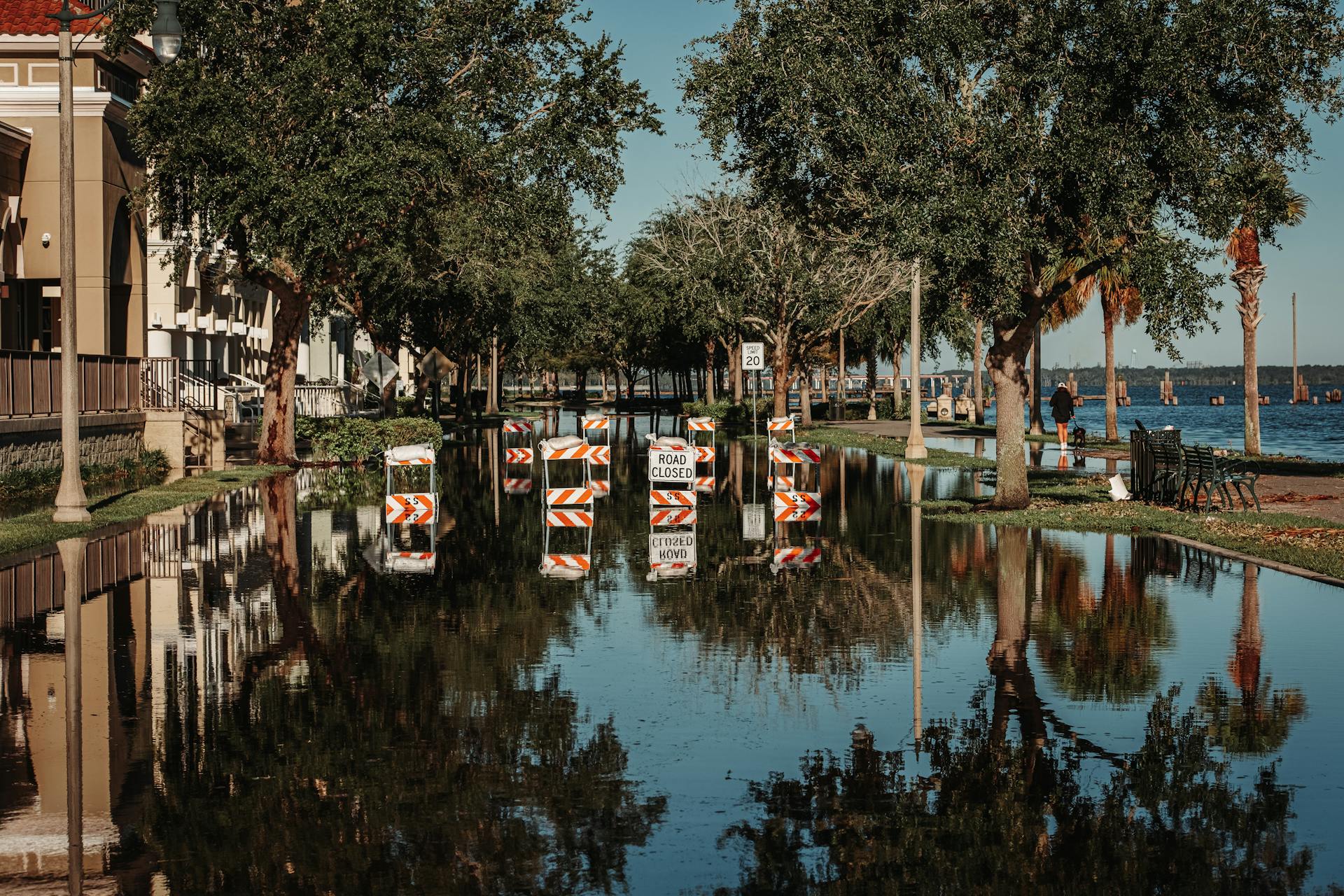
Water backup insurance is a crucial addition to your home policy, but what exactly does it cover? Typically, water backup insurance covers damage caused by sewage backups, sump pump failures, and overflows from appliances like washing machines and dishwashers.
This type of insurance usually doesn't cover damage from natural disasters like floods, which are often covered by separate flood insurance policies. It's essential to understand the specific coverage limits and exclusions in your policy.
A standard water backup insurance policy might cover up to $50,000 in damages, depending on the policy and provider. This can help you pay for repairs and replacements if your home is affected by a water backup.
In the event of a water backup, you'll want to act quickly to minimize damage and file a claim with your insurance provider.
On a similar theme: Does Homeowners Insurance Cover Sewage Backup
What Water Backup Insurance Covers
Water backup insurance typically covers damage to the sewer line that runs from your house to the city main, removal of standing sewage from your house, and damage caused by standing sewage (up to coverage limits). This is a crucial aspect of water backup insurance that you should be aware of.
Damage to your home's structural elements, such as floors and walls, and personal property, such as furniture and electronics, are also covered under water backup insurance. This coverage can be added to your standard homeowners insurance policy as an optional add-on.
Here are some specific things that water backup insurance covers:
- Damage to the sewer line that runs from your house to the city main
- Removal of standing sewage from your house
- Damage caused by standing sewage (up to coverage limits)
- Damage to your home's structural elements, such as floors and walls
- Damage to personal property, such as furniture and electronics
Typically Covers
Sewer backup insurance provides coverage for damage to your home's sewer line up to the city mainline. This includes the cost of draining excess water and sewer from your home.
The coverage usually includes damages to your home caused by water backups, such as structural damage and damage to home furnishings.
You can expect sewer backup insurance to cover the cost of removing standing sewage from your home, as well as damage caused by standing sewage, up to your coverage limits.
Here's a breakdown of what sewer backup insurance typically covers:
- Damage to the sewer line that runs from your house to the city main.
- Removal of standing sewage from your house.
- Damage caused by standing sewage (up to coverage limits).
Keep in mind that sewer backup insurance is usually an endorsement added to your standard homeowners insurance policy, and the specifics may vary depending on your insurance provider and policy.
What's Not Covered
Water backup insurance can be a lifesaver, but it's essential to know what's not covered. A faulty or damaged plumbing system in your house is not typically covered by sewer backup insurance.
If you don't maintain your plumbing system properly, damages caused over time won't be reimbursed. This is a crucial point to remember, as poor maintenance can lead to costly repairs down the line.
You won't be covered for standing sewage caused by city or municipality mismanagement. This is a common issue in many areas, and it's essential to know who to hold accountable.
A broken sump pump is not covered by water backup insurance, so you'll need to purchase equipment breakdown coverage separately. This is a separate type of coverage that's essential for protecting your home.
Other exclusions include overflow or backups caused by maintenance issues or neglect. This can include things like clogged drains or faulty appliances.
Explore further: Why Is Anucort-hc Not Covered by Insurance?
Water damage caused by flooding, waves, your pool, or any other body of water is also not covered. This is a critical point to remember, especially if you live in a flood-prone area.
Here's a quick rundown of what's not covered by water backup insurance:
- Broken sump pumps (equipment breakdown coverage needed)
- Overflow or backups caused by maintenance issues or neglect
- Water damage caused by flooding, waves, pool, or other body of water
Causes and Prevention
Water back-up and sump pump overflows can be a major headache, especially if you live in a wet climate. Heavy rain and large amounts of snow thawing can cause water to back-up into your home.
A clogged drain or old pipes can also contribute to water back-up. Tree roots interfering with the plumbing can be a common issue.
Sump pumps can help collect excess water from around your home's foundation and pump it away from the house, but they're not perfect and can malfunction, leading to an overflow.
Explore further: Does Homeowners Insurance Cover Sump Pump Failure
Causes of
Causes of water back-up and sump pump issues can be quite varied. Clogged pipes are a common reason for sewage to back up into your house, often due to a lack of maintenance or flushing non-degradable items down the toilet.

Tree roots can also cause significant problems, breaking and collapsing underground pipes as they grow. If you notice your drains are moving slowly or hear unusual noises, have them checked immediately.
A broken line between your house and the main sewer can also cause sewage to flow into your property. Contact your local municipality if you suspect this is the reason behind sewage backup in your house.
Sump pump issues can lead to dampness in the basement or even flooding. If your sump pump fails, you'll need to consult with a plumber to fix the problem.
Old plumbing systems can also be prone to sewage issues, making it worth speaking with a plumber about updating your plumbing system to prevent backups.
For more insights, see: Does Home Owner Insurance Cover Plumbing
Overflow and Discharge Damage
Accidental discharge or overflow from plumbing is usually covered by standard home policies. Homeowners' insurance may help cover damage caused by leaking plumbing if the leak is sudden and accidental.
Recommended read: Does Florida Homeowners Insurance Cover Accidental Falls in Florida
An overflow occurs when water bursts from the confines of a sewage system due to reaching its limit. For example, bathtub water spilling over and spreading all over the bathroom floor is an overflow.
Discharge occurs when water is flowing out from a leaking pipe, but there's no overflow, just a leak in the wrong place. Homeowners' insurance may also cover damage caused by sudden and accidental leaks, such as a washing machine's supply hose suddenly breaking.
A burst pipe can cause discharge damage, just like a leaky pipe. Homeowners should be aware of the risks and take steps to prevent such accidents.
Related reading: Does Renters Insurance Cover Toilet Overflow
Policy and Cost
The average cost of water backup insurance is around $50 to $250 annually, which is a relatively small price to pay for peace of mind.
You can choose to purchase water backup coverage as an add-on to your home insurance policy or as a standalone policy, depending on your needs and budget.
The cost of water backup insurance will also depend on the coverage limits you choose, with options for replacement costs limits up to $5,000 or full replacement cost for your home.
Here's a breakdown of the average costs for water backup insurance:
Keep in mind that these costs can vary depending on your insurance company and the specific factors of your standard home insurance policy.
Standard Homeowner Policies
Standard Homeowner Policies are a must-know for any homeowner. Your standard policy will likely cover damages due to the weight of ice, snow, or sleet.
You should be familiar with the types of water damage that are covered under a standard policy. These include damages from the discharge and overflow of water, even if it resulted from an accident.
Burning, cracking, tearing apart, bulging of steam, or heating system damage is also covered. Freezing of plumbing and pipes is another type of water damage that's typically covered.
Here are some key terms you might hear when making a claim: sewer backup or water backup, overflow and discharge, and flood.
It's worth noting that not all types of water damage are covered under a standard policy. For example, standard policies do not cover sewer backup.
For more insights, see: Does Homeowners Insurance Cover Water Damage from Toilet Overflow
How to Get Coverage with Progressive
If you're looking to get coverage with Progressive, know that their standard homeowners insurance policy doesn't typically protect your home against water backup damage.
You can add this optional type of coverage to your policy, which will provide protection against water backup damage.
Progressive's sewer backup insurance typically covers damage to the sewer line that runs from your house to the city main, removal of standing sewage from your house, and damage caused by standing sewage up to coverage limits.
Here's a breakdown of what you can expect from Progressive's sewer backup insurance:
Sewer backup coverage with Progressive only protects you up to your policy limits for things like structural damage and home furnishings.
Policy Inclusion
Standard homeowners insurance policies typically cover water damage caused by sudden and accidental events, such as the weight of ice, snow, or sleet, or the discharge and overflow of water due to an accident.
These policies usually include coverage for damages caused by the burning, cracking, tearing apart, or bulging of steam or heating systems, as well as the freezing of plumbing and pipes.

However, standard policies do not typically protect against water backup damage, which is a common type of water damage.
To protect against water backup damage, you can add an optional coverage endorsement to your standard homeowners insurance policy.
Sewer backup coverage is usually an endorsement that can be added to a standard homeowners insurance policy, and it provides coverage for damage caused by sewer or water backup.
This type of coverage typically includes damage to the sewer line that runs from your house to the city main, removal of standing sewage from your house, and damage caused by standing sewage.
Here are some common things that sewer backup insurance typically covers:
Cost
The cost of sewer backup insurance can vary depending on several factors. The average annual cost is around $1,237.
You can expect to pay between $50 to $250 or more annually for sewer backup coverage as an endorsement to your homeowner's insurance policy. This cost can add up over time.
A fresh viewpoint: Will Homeowners Insurance Cover Sewer Line Replacement
The cost of sewer backup insurance will also depend on the coverage limits you choose. Some policies offer replacement cost limits up to $5,000 or full replacement cost for your home.
Here are some estimated annual costs for sewer backup insurance:
Not Typically Cover
Standard homeowners insurance policies don't usually protect against water backup damage, so if you want this coverage, you'll need to add it to your policy.
A faulty or damaged plumbing system in your house is not typically covered by sewer backup insurance.
Damages caused over time by poor maintenance are also not covered.
Standing sewage caused by city or municipality mismanagement is usually not the responsibility of your insurance company.
Here's a breakdown of what's not typically covered by sewer backup insurance:
- A faulty or damaged plumbing system in your house.
- Damages caused over time by poor maintenance.
- Standing sewage caused by city or municipality mismanagement.
These are just a few examples of what may not be covered by your policy, so make sure you read and understand the fine print before purchasing sewer backup coverage.
Sources
- https://www.teamais.net/blog/home-insurance-what-is-water-back-up-insurance/
- https://www.bankrate.com/insurance/homeowners-insurance/sewer-backup-insurance/
- https://tatuminsurance.com/sewer-backup-insurance-cover/
- https://tgsinsurance.com/water-backup-coverage-faqs/
- https://www.progressive.com/answers/home-insurance-water-backup-coverage/
Featured Images: pexels.com


